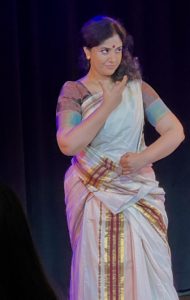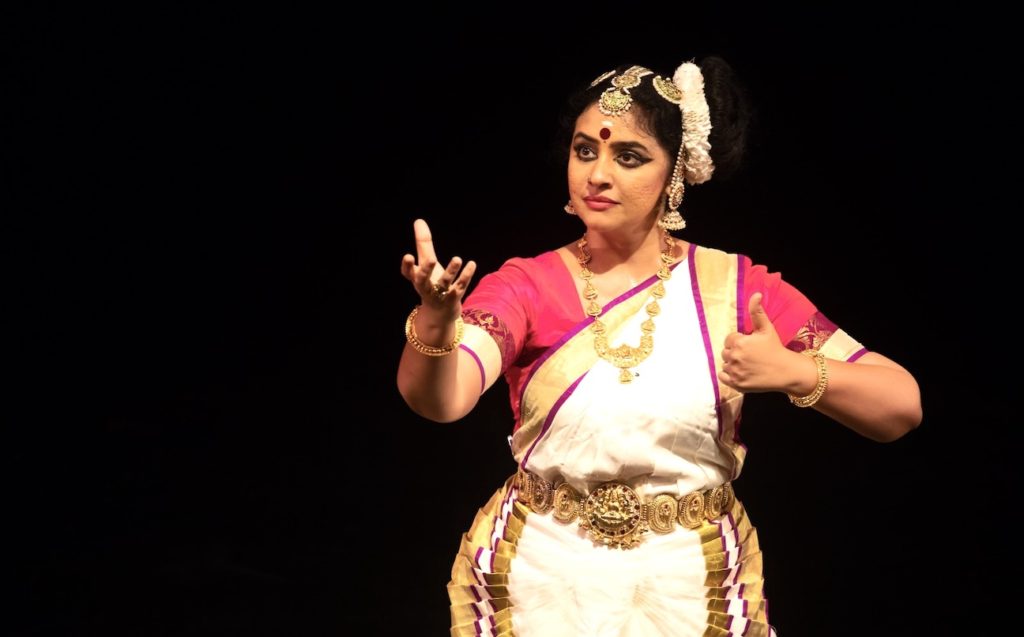Life Moves: Mohiniattam, a cultural seduction - Vancouver Ballet Society
- Home
- Life Moves
- Life Moves: Mohiniattam, a cultural seduction

By Susheela Menon
The dancer moves to the beat of the idakka, a highly revered percussion instrument of Kerala, at a 2000-year-old temple in South India. She moves from one sanctum to the other till reaching the shrine of Kali, the most powerful goddess in the Hindu pantheon. A crowd gathers as she dances before the silent altar. Her steps reflect both strength and grace, like a palm tree bending to the breeze of Kerala’s glorious monsoon.

I am watching this on film, part of a lecture demonstration on Mohiniattam by Indian dancer Methil Devika at Goodman Arts Centre in Singapore. I first saw Methil perform at a college event in the sleepy town of Palakkad in central Kerala, where we both studied commerce more than three decades ago. I was new to Kerala then, and to Mohiniattam, too. Yet this 18th-century dance form gripped my senses.
The city of Mumbai where I grew up was full of dynamic bhangra, a folk dance of Punjab, and garba, a religious dance with origins in Gujarat. Mumbai also danced to the beats of the Hindi movie industry. But none of these dance forms could tell a story as beautifully as Mohiniattam.
I still remember Methil’s gold-laced white sari, paired with a red blouse that sparkled in the sun. A large vermilion dot, which represents the spirit’s intuitive eye, blazed on her forehead.
Although I’m excited to see her perform in Singapore, where I now live, taking Mohiniattam out of India has never been Methil’s aim. “Ceremonial dances were once performed in temples across Tamizhagam, the southernmost region of the Indian subcontinent,” Methil said at the lecture demonstration. “I would love to see that happen again. Just imagine how different the ideation and energy will be then.”
Yet she is driven to popularize the form through innovative ideas. In her documentary, a 2018 Oscar contender, Sarpatatwam, The Serpent Wisdom, Methil uses Mohiniattam to interpret the philosophy of an 11th-century seer, Pambatti Siddhar. Her intention is to expand the possibilities of a dance form that has seen more ups and downs than the majestic mountain ranges in Kerala from where it rises.

A day after the lecture, I attended her performance at the Esplanade Theatre Studio, where she danced to traditional music composed by a small group of musicians from Kerala. Methil presented a mixed bill titled Anaavaran (Unveiling), showcasing the versatility of the form as well as her skills in movement, rhythm, expression, and narrative flow. The works ranged from the legendary story of Hindu god Krishna (Song of the Feather) and a light-hearted family drama, to the depiction of goddess Kali as a child, and the Mridu Tandava, a gentle version of the usually fierce cosmic dance of Shiva.
Dance is an inseparable part of Indian folklore, especially Hindu mythology, because its most prominent deities, from Vishnu and Krishna to Kali and Shiva, are believed to have danced at some point in their mythical journeys. Mohiniattam takes its name from Vishnu’s female avatar of Mohini, a seductress who helped the gods win back a pot of nectar the demons had stolen.

The history of Mohiniattam — which was inspired by the dance of devadasis, young girls raised as offerings to the Lord — is shrouded in mystery as its path has never been well-documented. The Maharaja of Travancore revived the form in the 19th century, when the beauty of Mohiniattam drew him to feature it at traditional festivals. He also wrote stories that were converted into dance dramas.
After his death in 1846, the onus of sustaining the form fell on Keralite poet Vallathol, who, in 1930, founded Kerala Kalamandalam, one of India’s most respected performing arts centres. Vallathol and his student Kalyanikutty Amma, who is fondly remembered as the Mother of Mohiniattam, brought in a new structure and discipline so more young girls would be drawn to the form. One of Kalyanikutty Amma’s students, Girija Chandran, was Methil’s teacher.
There is a meditative quality to Mohiniattam, a slowness and stability that keeps the dancer focused on her bodily movements. This is perhaps why Methil says she considers the seduction in Mohiniattam to be the captivation by the dancer of her own soul.
Since that first encounter, Methil moved on to receive numerous awards and earn a PhD in Mohiniattam from Bharathidasan University, Tamil Nadu, and I moved away from commerce and Kerala to Singapore. Since 2018, she has been an adjunct professor at York University in Toronto while I switched to blogging and story-writing.
Life moves as stories. As does Mohiniattam, which flows with rhythm, passion, and grace. Perhaps that’s why this dance form gripped my senses all those years ago in that little town in central Kerala. I love stories, and Mohiniattam reflects my love back at me.

